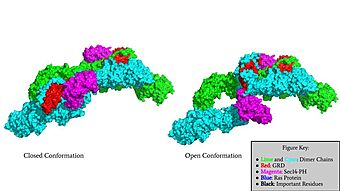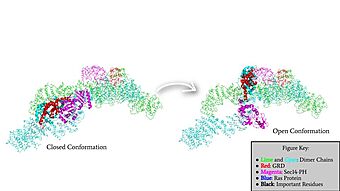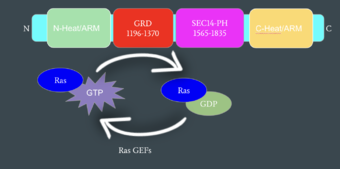Sandbox Reserved 1710
From Proteopedia
(Difference between revisions)
| Line 28: | Line 28: | ||
Neurofibromin is an essential protein and is involved mainly in the differentiation of neural crest-derived cells, mesenchymal cells, neural cells, melanocytes, and bone cells. As Neurofibromin is essential for embryonic development, mutations to the NF1 gene can result in psychological retardation resulting from Type I neurofibromatosis. Most of the 1485 mutations identified lead to a synthesis of truncated, non-functional protein and are a result of point mutations. Type I Neurofibromatosis is inherited in an autosomal dominant manner but about 50% of cases de novo ones. <ref name="Abramowicz">PMID:25182393</ref> | Neurofibromin is an essential protein and is involved mainly in the differentiation of neural crest-derived cells, mesenchymal cells, neural cells, melanocytes, and bone cells. As Neurofibromin is essential for embryonic development, mutations to the NF1 gene can result in psychological retardation resulting from Type I neurofibromatosis. Most of the 1485 mutations identified lead to a synthesis of truncated, non-functional protein and are a result of point mutations. Type I Neurofibromatosis is inherited in an autosomal dominant manner but about 50% of cases de novo ones. <ref name="Abramowicz">PMID:25182393</ref> | ||
| - | Mutations of the gene NF1 can lead to major structural and functional changes that are dangerous for the patient. | + | Mutations of the gene NF1 can lead to major structural and functional changes that are dangerous for the patient. NF1 mutation(s) can result in the complete loss of function and the inability to interact with the Ras protein. If interaction with Ras cannot occur, no conversion of GTP to GDP occurs and, therefore, no inactivation of Ras. Consequently, there is nothing limiting Ras from promoting cell growth. Uncontrolled cell growth leads to tumors and puts patients at a much higher risk for cancer. Mutations in the NF1 gene have been found in sporadic cancers such as glioblastoma, neuroblastoma, lung cancer, ovarian cancer, and breast cancer. Additionally, NF1 is one of the top ten genes that are most mutated in tumors of the lung, breast, ovary, pancreas, and prostate. Researchers are still unsure as to whether biallelic loss of NF1 is common or if it is only a hemizygous loss of the gene that contributes to the growth progression of certain sporadic tumors. It is possible that the order of mutations affects the grade of a tumor (for certain types of cells) and thus explains why NF1 patients are not predisposed to certain types of sporadic tumors.<ref name="Ratner">PMID:25877329</ref> |
== Student Contributors == | == Student Contributors == | ||
Revision as of 19:31, 29 March 2022
| This Sandbox is Reserved from February 28 through September 1, 2022 for use in the course CH462 Biochemistry II taught by R. Jeremy Johnson at the Butler University, Indianapolis, USA. This reservation includes Sandbox Reserved 1700 through Sandbox Reserved 1729. |
To get started:
More help: Help:Editing |
Human Neurofibromin - The Tumor Suppressor Gene
| |||||||||||
References
- ↑ Naschberger A, Baradaran R, Rupp B, Carroni M. The structure of neurofibromin isoform 2 reveals different functional states. Nature. 2021 Nov;599(7884):315-319. doi: 10.1038/s41586-021-04024-x. Epub 2021, Oct 27. PMID:34707296 doi:http://dx.doi.org/10.1038/s41586-021-04024-x
- ↑ Trovo-Marqui AB, Tajara EH. Neurofibromin: a general outlook. Clin Genet. 2006 Jul;70(1):1-13. doi: 10.1111/j.1399-0004.2006.00639.x. PMID:16813595 doi:http://dx.doi.org/10.1111/j.1399-0004.2006.00639.x
- ↑ Lupton CJ, Bayly-Jones C, D'Andrea L, Huang C, Schittenhelm RB, Venugopal H, Whisstock JC, Halls ML, Ellisdon AM. The cryo-EM structure of the human neurofibromin dimer reveals the molecular basis for neurofibromatosis type 1. Nat Struct Mol Biol. 2021 Dec;28(12):982-988. doi: 10.1038/s41594-021-00687-2., Epub 2021 Dec 9. PMID:34887559 doi:http://dx.doi.org/10.1038/s41594-021-00687-2
- ↑ 4.0 4.1 4.2 Ratner N, Miller SJ. A RASopathy gene commonly mutated in cancer: the neurofibromatosis type 1 tumour suppressor. Nat Rev Cancer. 2015 May;15(5):290-301. doi: 10.1038/nrc3911. Epub 2015 Apr 16. PMID:25877329 doi:http://dx.doi.org/10.1038/nrc3911
- ↑ Abramowicz A, Gos M. Neurofibromin in neurofibromatosis type 1 - mutations in NF1gene as a cause of disease. Dev Period Med. 2014 Jul-Sep;18(3):297-306. PMID:25182393



